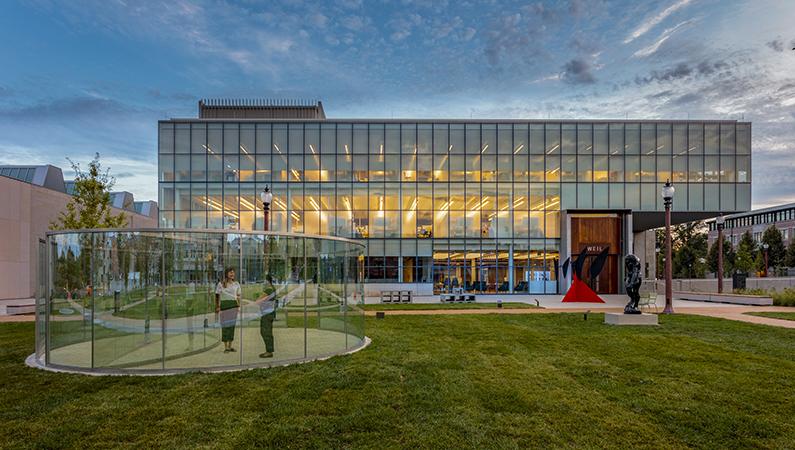The Sam Fox School is an inspiring place for learning, making, and creative research. Our six-building complex features numerous exhibition and maker spaces, a dedicated art and architecture library, and a world-class art museum. Our students have unparalleled resources that support a positive creative culture.
In response to the COVID-19 pandemic, we have taken numerous measures to provide a safe learning environment for our students and faculty, allowing them to continue to take courses on campus and use studios and facilities. These measures include a new reservation system and zone spacing for our shops, cohort rotations for some of our classes, designated eating spaces, and a requirement to wear masks at all times inside buildings. To learn more about our enhanced health and safety protocols, visit insidesamfox.wustl.edu/covid-19.
Take the 360° tour of our spaces>>
See more images of campus>>
To promote an integrated learning experience, all of the Sam Fox School's programs are united on the East End of the main WashU campus. This provides the best opportunity for camaraderie and collaboration across disciplines while providing optimal access to the tremendous intellectual and physical resources of the University.
Completed in fall 2019 as part of the University's East End transformation project, Anabeth and John Weil Hall exemplifies the cross-disciplinary spirit of our campus. All of our graduate programs are based here, inviting opportunities for meaningful, everyday exchange. The building—which achieved LEED Platinum certification from the U.S. Green Building Council—provides 82,000 square feet for programs, with state-of-the-art studios, including the William A. Bernoudy Artchitecture Studio and the Roxanne H. Frank Design Studio, as well as classrooms, and digital fabrication spaces. Its ambitious design, abundant natural light, and flexible, loft-style studios and workspaces, make Weil Hall a new locus for teaching, study, creation, and critique.

Caleres Fabrication Studio in Weil Hall.
The Caleres Fabrication Studio is both the physical and conceputal heart of Weil Hall. Students and faculty across programs can execute complex projects using industry-grade tools, including laser cutters, 3D printers, a large-format CNC milling machine, vacuum and thermoforming, and a knife plotter.

Dubinsky Printmaking Studio, Bixby Hall.
The second floor of Bixby Hall features an expansive integrated printmaking atelier for letterpress, etching, lithography, and illustrated books. It is home to the Dubinsky Printmaking Studio and the Nancy Spirtas Kranzberg Studio for the Illustrated Book, a collaboration with WashU Libraries. The suite also houses Island Press, a research-based printmaking workshop that creates and publishes innovative prints and multiples by many of today’s most influential artists.
The Sam Fox School has wood and metal shops that are staffed by expert teaching technicians. Walker Hall houses plaster and mold-making, foundry, and ceramics facilities, including several ironworkers and kilns. Interior courtyards in Walker and Weil Halls, plus numerous exterior spaces, provide opportunities for large-scale investigations. In Givens Hall, a new textile studio enables exploration with traditional techniques like batik and screen-printing as well as 3D-printed fabrics and accessories, experimental and sustainable textile recycling, and architectural applications.

Work from the Collaborative Technology Center, Weil Hall.
Students who wish to work with photography, animation, video, and sound will find ample resources for media production. The Collaborative Technology Center on the lower level of Weil Hall is equipped with imaging software like Maya, Premier Pro, and After Effects, and staffed by faculty who lead workshops and can assist with experimental time-based arts. The Whitaker Learning Lab in Steinberg Hall has large-format printing for photographs and architectural renderings. In the lighting studio, students can set up professional photo shoots for fashion, advertising, and documentation, and rent specialty equipment, like large-format cameras. We also maintain a traditional darkroom. In addition, WashU's Harvey Media Center offers a green screen, podcast studio, and media rentals.
Students can explore conventional and experimental techniques with oils, collage, pastels, cut paper, illustration, and hybrid works in many of our studios. Juniors, seniors, and graduate art students focusing on painting-based practices have spacious individual studios with abundant natural light and communal storage for flatwork. Students interested in these areas may utilize the School's printmaking suite for editioning.

Installation view of Tomás Saraceno: Cloud-Specific at the Kemper Art Museum.
Students benefit from direct access to the resources of the School's Kemper Art Museum, which has a robust exhibition program and one of the finest university collections in the United States. Recent exhibitions include Ai Weiwei: Bare Life, To See Without Being Seen: Contemporary Art and Drone Warfare, and Drawing Ambience: Alvin Boyarsky and the Architectural Association. The Museum's Teaching Gallery offers faculty and student fellows a space to curate an exhibition from the permanent collection.

BFA in Art exhibition opening at the Des Lee Gallery.
The School maintains three galleries: Steinberg Hall Gallery, Weitman Gallery, and the Des Lee Gallery in the heart of the historic Washington Avenue Loft District downtown. Installation spaces throughout our spaces are available for students to reserve for temporary exhibitions and interventions. The annual MFA in Visual Art Thesis Exhibition is held in the Museum’s main galleries each spring.

Kenneth and Nancy Kranzberg Art & Architecture Library, lower level, Kemper Art Museum.
The Washington University Libraries feature 12 distinct sites, vast print and electronic collections, and expert librarians whose first priority is helping students and faculty find the information they need. The Kenneth and Nancy Kranzberg Art & Architecture Library, located on the lower level of the Museum, holds more than 105,000 volumes in various media, and subscribes to the foremost electronic article indexes, e-book reference works, and digital image databases. The D.B. Dowd Modern Graphic History Library, a division of Special Collections, is a preeminent site for studying the history and culture of American illustration, comprised of original art and printed material from many fields of popular American pictorial graphic culture. Focusing on 20th century illustration, the collection includes artists' working materials and sketches as well as original artwork from books, magazines, and advertising.



